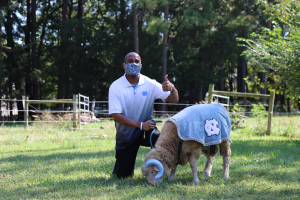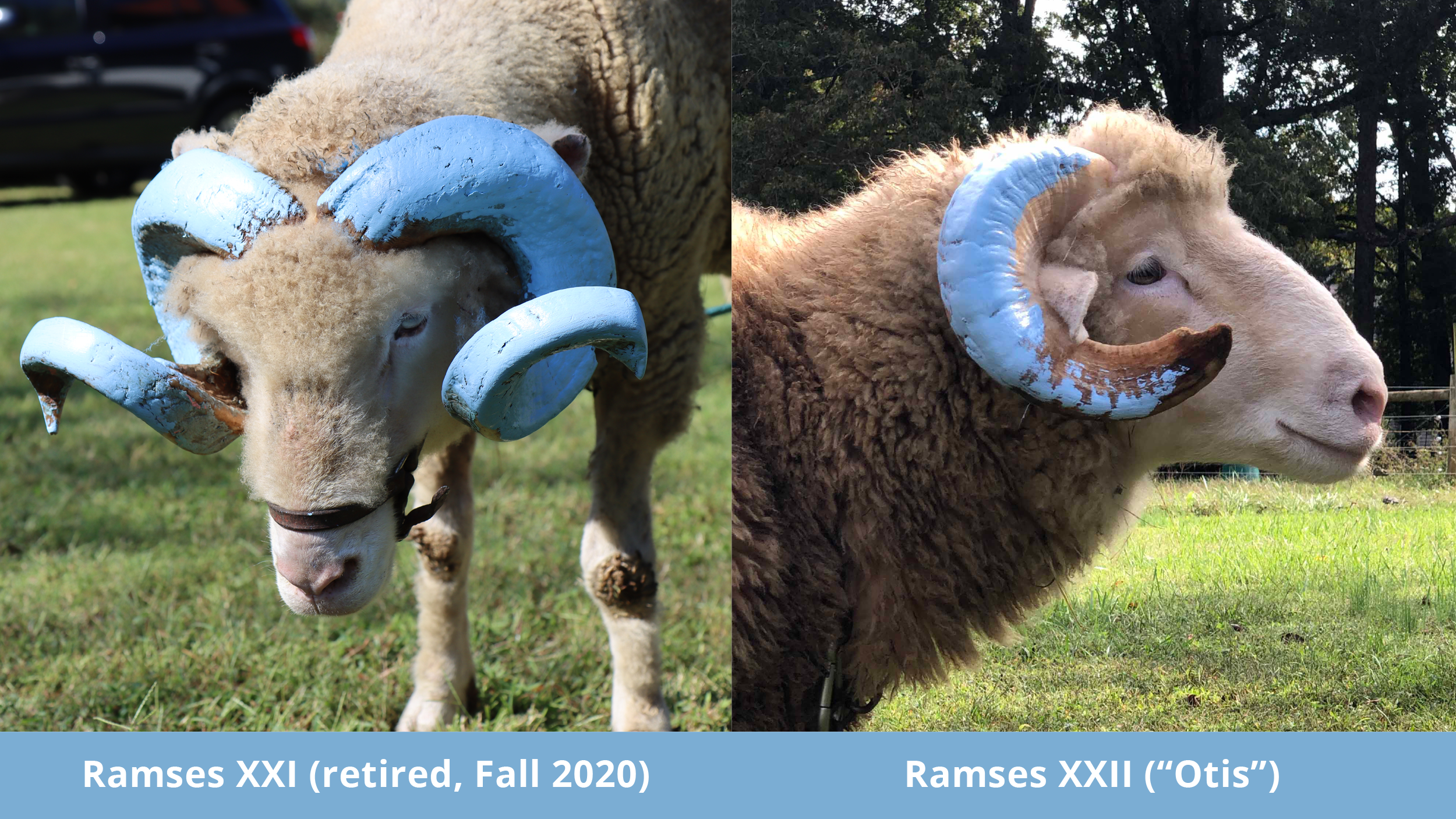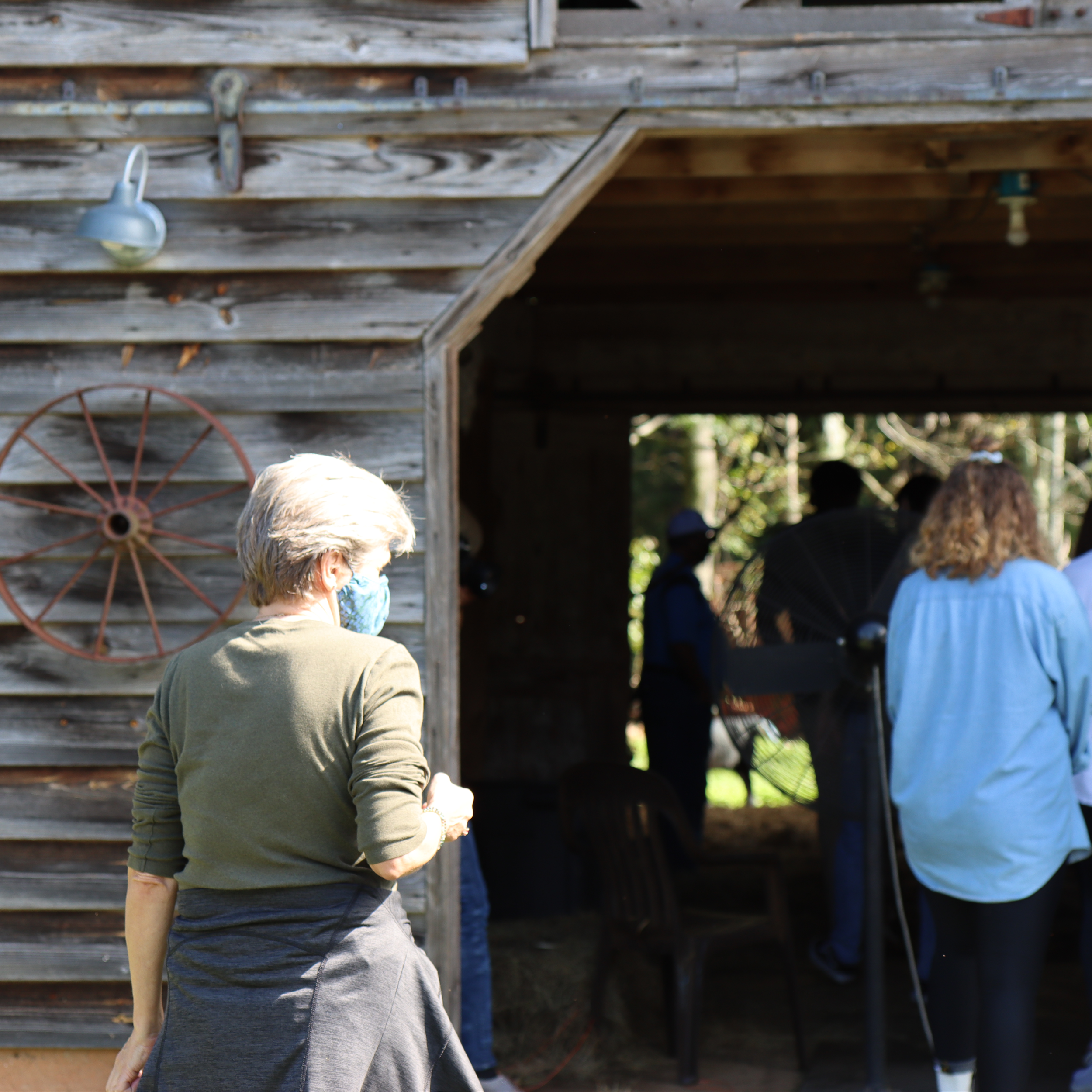UNC Hussman’s fall 2020 “PR Campaigns” class takes on Rameses XXII as a client

by Barbara Wiedemann
Think back to the game clock winding down for a win at your last home game in Kenan Stadium. Coach Brown is heading to the locker room for some signature dance moves with his players. You and tens of thousands of Carolina fans are being herded out of the stadium, talking about where to celebrate the win as you walk past Wilson Library and cut through Polk Place on your way to Franklin Street. Do you wonder where Rameses, UNC’s live mascot, goes when the stadium lights go down?
We know where Rameses goes
UNC Hussman Teaching Assistant Professor Livis Freeman (above right with Rameses) and his fall 2020 MEJO 634 “Public Relations Campaigns” class know where Rameses goes. They know how he gets there, what he eats before and after the game, how long it took to acclimate him to time spent with stadiums full of football fans, who refreshes the paint on his blue horns and what his vet bills come to every year.
The class of mostly advertising and public relations juniors and seniors at Carolina took on Rameses and his longtime family of caretakers at Hogan’s Magnolia View Farms as a client this semester. The opportunity to work with Rameses came from Hussman Adjunct Professor Marshéle Carter, who had just written a feature story on Rameses’ caretakers for “Our State” magazine.
“On that first day of class, Livis talked about past clients like Air Jordan. Nike. Fox Sports,” said Ad/PR and psychology major Brandon Standley ’21, managing editor of the student-run Daily Tar Heel newspaper. “I knew we were in for something serious. But when he introduced Rameses’ caretakers as our client, I thought ‘There is no better client to have this semester than our own live mascot!’ I was hooked.”
The class divided up into five groups, or “mini-PR firms,” as Freeman calls them, and competed to win a contract for an awareness campaign highlighting Rameses’ history and legend. The goal was also to emphasize what it takes to sustain the live mascot’s place — literally and figuratively — at Carolina.
The students spent a month learning all about what it takes to keep a ram healthy and happily interacting with Tar Heel fans. That included a visit to the farm off of Old Highway 86 in Chapel Hill, where they met Rameses XXI — who just retired — and the upstart young Rameses XXII. Nicknamed “Otis” before he ascended to mascot status earlier this semester, the young Horned Dorset ram born last spring is stepping into a tradition that goes back to 1924 according to university records.

Freeman’s professional network as the founder of 4ourFans, a public and community relations company helping professional athletes create their charitable identities, helped open some doors for students. It led to conversations with people like UNC Athletics Assistant Athletic Director Michael Beale about the ram’s legacy.
“Getting Rameses more accessible to fans on game days is something we’ve seen other schools have large success with,” said Beale, “particularly when student organizations have taken it on.”
Each student group conducted multiple interviews, did surveys, ran focus groups and did independent research on the history of Rameses and how other colleges and universities work with live and costumed mascots. All “P.R. Campaigns” teams gathered data on the Hogan family’s efforts to make Rameses available during football games and other Carolina-related events.
“We didn’t expect that even those in the Carolina community who had never met Rameses, or didn’t even know we had a live mascot, would feel so strongly connected to him, and be so supportive of him as a brand mascot,” said Standley.
The pitch
Research in hand, each group brainstormed together. The thinking was long term — what would it take make the nearly 100-year-old program sustainable for another century?
A creative set of fresh ideas were proposed on pitch day in the form of Zoom presentations and one polished video presentation, with detailed plans outlined for how to achieve them.

Standley remembers refining the video after work at The Daily Tar Heel on the Sunday before LDOC (last day of class) at Carolina, detailing the perfect storm of due dates familiar to journalism school graduates throughout the ages. “It was due Monday at 9 a.m.,” he said. “And I wasn’t totally happy with the video. So Sarah Holley was editing the paper and I was editing video until about 5:30 that morning.”
From cross-collaboration with the costumed mascot, to an active website dedicated to the ram, a children’s book about the Horned Dorset, “meet Rameses” Instagram events and some ideas which cannot yet be revealed publicly, all-new approaches were encouraged and supported by Freeman as he watched the campaigns unfold.
“Each presentation gave me chills,” said Ann Hogan Leonard (at left in photo), whose late husband’s great grandfather started the Hogan family’s Rameses tradition. “Each was different and had wonderful ideas. It’s exciting that as we move forward, we can cherry-pick the ideas and take some great ones from each group.”
Leonard added, “The research brought up some interesting common themes, including the affection and love within the student body for Carolina’s Rameses tradition.”
Hooked for life
Freeman has plans to host a Zoom meeting between the Rameses caretakers and Carolina’s Athletics department later this month, to talk through the live mascot’s short- and long-term future on campus.

“We are interested in learning more,” said Assistant AD Beale. “How we pull this off will require some support from other areas of campus, but we’re glad that Livis and his class wanted to start with us so we could give our perspective. We’re looking forward to some good conversations moving forward.”
Fortunately, the mini-PR firms in Freeman’s course reached out to dozens of groups across the Carolina community asking if they might have an interest in sustaining the live mascot program. And the answer in all cases was a resounding “Yes,” according to Standley.
“What the student’s work uncovered is that we’re not doing all that we could with Rameses right now,” said Leonard. She is excited about what the MEJO 634 class’ research and proposals uncovered, which she sees as a lot of new opportunities for working with “Otis,” the young ram she describes as “just so good and so very gentle, he just took so well to the training.”
A football game next fall in Kenan Stadium, with the chance to pet young “Otis” or take a selfie, is something we might all look forward to in 2021.
“The tradition makes people feel good. It makes us feel good,” said Leonard. “That is something to cherish.” It is something she hopes to nurture with a team of Carolina community partners in the future.
“I have such deep respect for the Hogan family and for Rameses as a Carolina institution,” said Standley. “Once you pet him once, you’re hooked for life.”
If your organization is interested in supporting “Otis” on campus, please contact UNC Hussman Teaching Assistant Professor Livis Freeman at lfreeman@email.unc.edu.